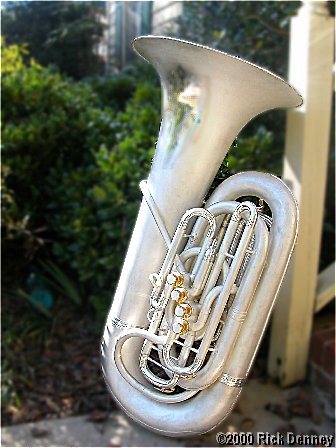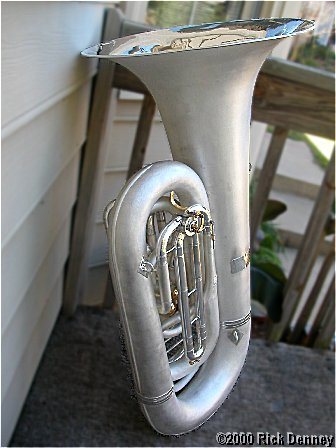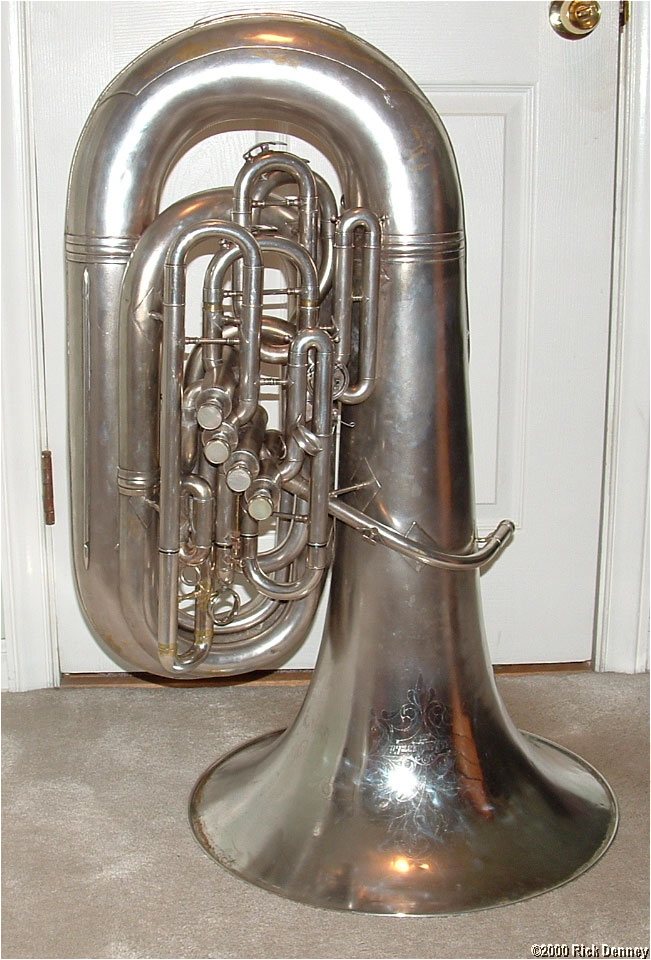An Image Repository for York Tubas
This is the start of a long-contemplated project. I have long hoped to build an online library of images of York tubas of various vintages, as a means of documenting their details. Eventually, this page will be the jumping-off point for a reproduction of a 1920's J.W. York and Sons catalog, as well as a gallery of images of York tubas from throughout history.
The point of having a gallery is to see the physical nature of instruments that are so highly regarded for their musical nature. Of course, their appearance defies connection to their sound, and it's not impossible that their sound defies connection to reality. I will present images of York-branded tubas not made in the York factory, because even those made in the factory bear the fingerprints of a variety of makers and methods over the long history of the Grand Rapids plant. It's unlikely that these pictures will find the common thread that runs through all these variations, but it's fun to look and wonder.
With many examples of old Yorks being used as models for new tubas, I wonder what Pop Johnson would think. York could not survive commercially, but their designs are among the most revered in the tuba world, and have been propagated in a variety of directions.
1937 York 4/4 CC (added to Gallery 7/15/02)
Mike Johnson's email to me finally kick-started this project, and the images he sent deserve to be the first entry. This tuba was ordered by Arnold Jacobs in 1937 for a student. According to Mike, only twelve were built in this configuration. The forward bell is still with this instrument, as well as the original cases complete with fake crocodile skin. Paul Sidey reports in Tubenet that he learned from Bob Tucci that this instrument was owned by Harold McDonald and them by himself before it passed on to Mike. Bob Tucci is, of course, half of the Parantucci pair with Dan Parantoni, and is an orchestra professional in Europe as well as being the proprietor of a tuba store there. Paul also reports that Mr. Tucci used this instrument as the model for the B&S PT-606 (aka GR-41).
When I received Mike's email, there was no way I could let it languish in my in box, so here it is:
1938 York 4/4 CC (added to Gallery 2/22/05)
Jim Self has owned this tuba for quite a while, but recently decided to have it restored to like-new condition. Lee Stofer performed the work, using a satin silver finish that was common when the instrument was new. Jim is, of course, a well-known studio musician in Los Angeles, and is the tuba sound in innumerable Hollywood films. He has many instruments, which he writes about in his own web site, at http://www.bassethoundmusic.com. I'm grateful to Jim for granting permission to post these pictures here.
Here is what Jim recently wrote about this instrument:
Years ago George put an extension on the 4th valve which added the lower notes and helped with intonation. It worked so well that we left it on and Lee actually improved it by adding a second extension--which makes it fully chromatic to the pedals.
We put a small plaque (pedigree) on the back that recognizes it's original owner, George Boujie of the MGM Orchestra.
This is a special instrument. As a young man in Los Angeles, Roger Bobo knew what a great tuba this York was. The tuba has a great sound. It was the instrument that played all the MGM scores from 1938 into the '60s--like "Wizard of Oz" and George used it for all of the early Flintstones cartoons. Before Tommy Johnson, George Boujie was considered the best tuba soloist in the Hollywood Studios. After acquiring this from George in the early '90's, I used it on several studio calls including the many solos in the Walter Matthau film "Dennis the Menace".
Jim adds a little zinger: This instrument is being used as the model for a new Yamaha CC.


1935 York 4/4 CC (added 2/22/05, edited 9/28/2016)
This 4/4 York is owned by John Taylor (former editor of the International Tuba Euphonium Association Journal), and was photographed by Scott Mendoker. Sam Gnagey, a professional tuba player and creator of interesting hybrid tubas, posted this on Tubenet recently. He presented this photo in evidence of the purpose of the fifth valve, which he contended was to make the instrument playable in Bb. But John Taylor has refuted this notion based on the likelihood that Donatelli played only C tubas, which is evidenced by: 1. The York tuba made for Donatelli (subsequently sold to Jacobs) and the Conn "Donatelli Model" 4/4 tubas are pitched in C, and 2. John's understanding of Arnold Jacobs's comments suggesting that Donatelli played C tubas (Taylor studied with Jacobs starting in 1962). In any case, the fifth valve on this tuba is a long half-step, which John tells me he uses to tune C and F# which are sharp in the usual 2-4 fingerings.
This instrument has an extra loop for the third valve, which was originally part of the tuning slide and designed to tune the slide properly. John Taylor reports that it was inconvenient, because he was required to pull two slides to empty water from the third-valve branch. He had the valve reconfigured around 1997 to extend the main third-valve upper loop and close off this extra loop. The extra loop in the third-valve slide is similar to other examples (particularly one owned by past Pittsburgh Symphony tuba player Harold McDonald).
As nearly as I can tell, the label says "York Instrument Co." which was a name used between about 1928 and 1940. John tells me that the serial number suggests a date of 1935, with confirmation from Bob Rusk.

This page will grow as I work through my current folder of York images. Stay tuned.